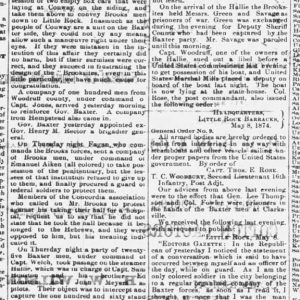calsfoundation@cals.org
Battle of Palarm (Reconstruction)
The Battle of Palarm was a skirmish in the Reconstruction-era Brooks-Baxter War in which supporters of Joseph Brooks attacked the steamboat Hallie (a light-draught fast packet) on the Arkansas River near present-day Mayflower (Faulkner County), killing several militiamen loyal to Elisha Baxter.
The election of 1872 was rife with irregularities but resulted in Elisha Baxter assuming the governorship of Arkansas. However, following a series of legislative and legal maneuvers, losing candidate Joseph Brooks won a legal ruling declaring him the winner. On April 15, 1874, Brooks and a group of armed followers confronted Baxter at the Old State House and threw him out, leading to several weeks of armed confrontations in what became known as the Brooks-Baxter War.
The Hallie steamed to Fort Smith (Sebastian County) in late April, where the Arkansas Gazette reported it was “detained…for forty-eight hours waiting on about sixty refugees who wanted to come down and get something to eat from Joe in the state-house. On the way down they would not allow her to land at Lewisburg for fear there might be a ‘Baxter reception committee’ awaiting them.” The Hallie was in Little Rock (Pulaski County) for two days when Robert C. Newton, a general of Baxter’s forces, ordered it upriver to intercept a shipment of weapons that Brooks backers had seized from the Arkansas Industrial University—now the University of Arkansas (UA) in Fayetteville (Washington County)—that were reported heading to the capital via flatboat. Between thirty and forty men from Captain Alexander Welch’s militia company (later known as the Hallie Rifles) and the commands of Captain Jack Cottrell and Captain O. S. Mask boarded the steamboat and set off toward Fort Smith on May 7, 1874.
James F. Fagan, commanding Brooks’s forces at the capitol, learned of the Hallie’s departure and ordered Colonel John (Jack) Brooker to take six companies of their militia and board a special train west to intercept the steamboat. The 200 men disembarked at the mouth of Palarm Creek on May 8 and took position along the banks of the Arkansas River. The Hallie, after stopping at Natural Steps (Pulaski County) for wood, approached the ambush. A Lieutenant Grove from Brookers’s troops met the vessel and ordered the Hallie to return to Little Rock. The steamer’s captain, Sam Houston, “answered him with his usual brusqueness and signaled the pilot to go ahead,” according to John Harrell’s history of the Brooks-Baxter War. The Brooks forces opened a “murderous fire” on the Hallie as the Baxter forces fired back from behind barricades of thick planks and cotton bales. A shot cut the Hallie’s steam pipe, leaving it to drift uncontrolled to the southern bank of the river, and the vessel was riddled by rifle fire.
On the Hallie, a man named Frank Timms was killed instantly, Houston was mortally wounded, and pilot John Meyers was shot in the chest, knee, and calf; he would die of his wounds on June 20. At least three other Baxter supporters were wounded—one, Bascomb Leigh, was left crippled—in the fight. At least three Brooks men were killed or mortally wounded.
The survivors from the Hallie escaped into the woods and made their way back to Little Rock. Brooker put two officers and twenty-four men aboard the steamboat to sail it back to the capital while the rest of his men returned by railroad. Early in the morning on May 10, the Hallie was scuttled in the Arkansas River during a raid by Baxter supporters; both sides blamed each other for the sinking. Five days later, President Ulysses S. Grant signaled his support for Baxter, who returned to the Old State House on May 19, ending the Brooks-Baxter War and Reconstruction in Arkansas.
For additional information:
Atkinson, James H. “The Brooks-Baxter Contest.” Arkansas Historical Quarterly 4 (Summer 1945): 124–149.
Christ, Mark K., ed. A Confused and Confusing Affair: Arkansas and Reconstruction. Little Rock: Butler Center Books, 2018.
DeBlack, Thomas A. With Fire and Sword: Arkansas, 1861–1874. Fayetteville: University of Arkansas Press, 2003.
“The Hallie Rifles.” Arkansas Gazette, May 9, 1875, p. 4.
Harrell, John M. The Brooks and Baxter War: A History of the Reconstruction Period in Arkansas. St. Louis: Slawson Printing Co., 1893. Online at https://archive.org/details/brooksbaxterwarh00harr/page/n3/mode/2up (accessed March 6, 2024).
“Honor to Whom It Is Due.” Arkansas Gazette, June 3, 1874, p. 4.
“Items in Brief.” Arkansas Gazette, June 21, 1874, p. 4.
Meriwether, Robert W. “The Brooks-Baxter War and the Battle at Palarm (1874).” Faulkner Facts and Fiddlings, 37 (Fall/Winter 1995): 70–73.
“River News.” Arkansas Gazette, May 5, 1874, p. 2.
“The Second Fight.” Arkansas Gazette, May 9, 1874, p. 1.
Singletary, Otis A. “Militia Disturbances in Arkansas during Reconstruction.” Arkansas Historical Quarterly 14 (Summer 1956): 140–150.
Mark K. Christ
Central Arkansas Library System
 Civil War through Reconstruction, 1861 through 1874
Civil War through Reconstruction, 1861 through 1874 Military
Military Hallie Steamboat Article
Hallie Steamboat Article 



Comments
No comments on this entry yet.